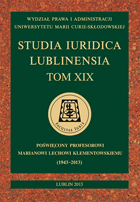Ludobójstwo: operacja polska NKWD (1937–1938). Uchwała Biura Politycznego KC WKP(b) oraz rozkazy szefa NKWD ZSRR
Genocide: Polish operation the NKVD (1937–1938). Politbureau KC WKP (b) Resolutions and the NKVD USSR chief’s commands
Author(s): Adam LityńskiContributor(s): Anula Witkowska (Translator)
Subject(s): Criminal Law, Military history, Criminology, Victimology, Interwar Period (1920 - 1939), Transformation Period (1990 - 2010)
Published by: Wydawnictwo Naukowe Uniwersytetu Marii Curie-Sklodowskiej
Summary/Abstract: After the Polish-Bolshevik war in 1921 between 1.1 and 1.2 million Polish people remained in Russia (later USSR). The sovietisation of Poles did not bring satisfying effects. A sense of national spirit was getting stronger. Polish operation was focusing on physical mass extermination of Poles only because of the fact they were Polish. It is estimated that 240,000–280,000 Polish citizens were arrested together with their families whereas between 220,000–250,000 Poles, most of which were the Soviet Union citizens, were shot dead or deprived of their lives in other ways, were shot dead or deprived of their lives in other ways. There are even some estimations talking about 400,000 murdered Poles. Polish operation had a typical characteristic of an ethnic cleansing and genocide. On the 14th July 2009 the Sejm of the Republic of Poland passed a resolution honoring the victims of crimes on Polish people between 1937–1939 and called it “a genocide”.
Journal: Studia Iuridica Lublinensia
- Issue Year: 19/2013
- Issue No: 1
- Page Range: 181-199
- Page Count: 19
- Language: Polish

